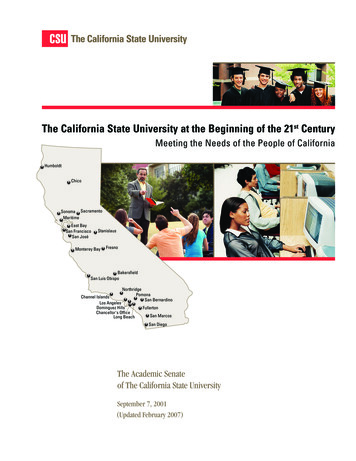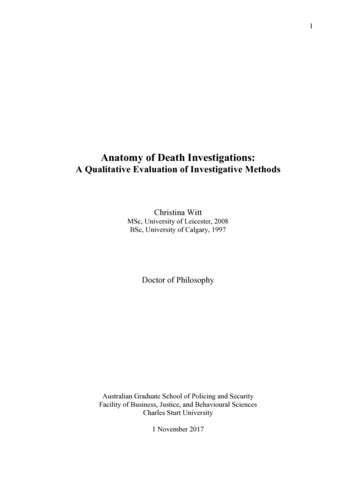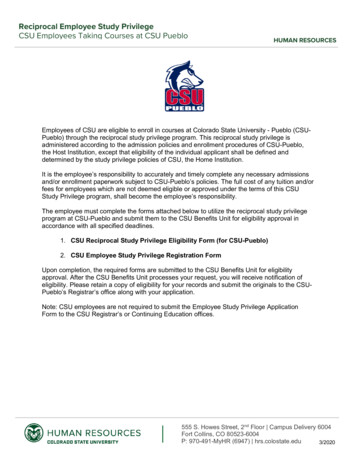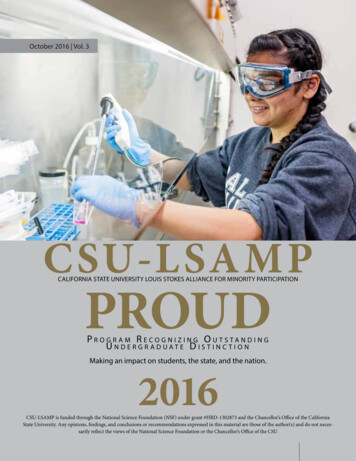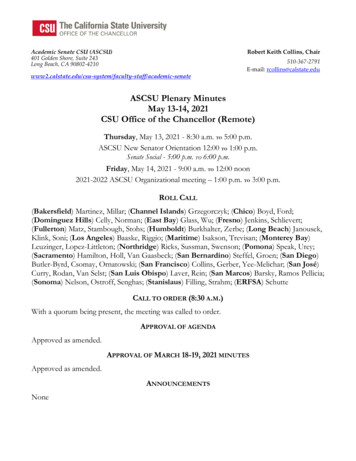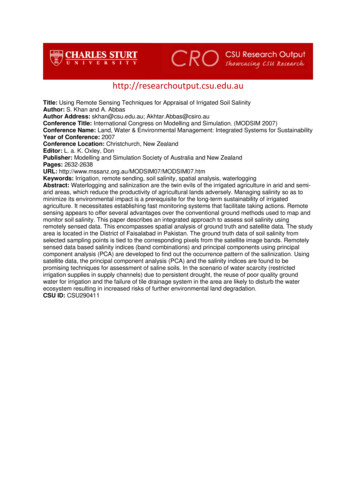
Transcription
http://researchoutput.csu.edu.auTitle: Using Remote Sensing Techniques for Appraisal of Irrigated Soil SalinityAuthor: S. Khan and A. AbbasAuthor Address: skhan@csu.edu.au; Akhtar.Abbas@csiro.auConference Title: International Congress on Modelling and Simulation. (MODSIM 2007)Conference Name: Land, Water & Environmental Management: Integrated Systems for SustainabilityYear of Conference: 2007Conference Location: Christchurch, New ZealandEditor: L. a. K. Oxley, DonPublisher: Modelling and Simulation Society of Australia and New ZealandPages: 2632-2638URL: ords: Irrigation, remote sending, soil salinity, spatial analysis, waterloggingAbstract: Waterlogging and salinization are the twin evils of the irrigated agriculture in arid and semiarid areas, which reduce the productivity of agricultural lands adversely. Managing salinity so as tominimize its environmental impact is a prerequisite for the long-term sustainability of irrigatedagriculture. It necessitates establishing fast monitoring systems that facilitate taking actions. Remotesensing appears to offer several advantages over the conventional ground methods used to map andmonitor soil salinity. This paper describes an integrated approach to assess soil salinity usingremotely sensed data. This encompasses spatial analysis of ground truth and satellite data. The studyarea is located in the District of Faisalabad in Pakistan. The ground truth data of soil salinity fromselected sampling points is tied to the corresponding pixels from the satellite image bands. Remotelysensed data based salinity indices (band combinations) and principal components using principalcomponent analysis (PCA) are developed to find out the occurrence pattern of the salinization. Usingsatellite data, the principal component analysis (PCA) and the salinity indices are found to bepromising techniques for assessment of saline soils. In the scenario of water scarcity (restrictedirrigation supplies in supply channels) due to persistent drought, the reuse of poor quality groundwater for irrigation and the failure of tile drainage system in the area are likely to disturb the waterecosystem resulting in increased risks of further environmental land degradation.CSU ID: CSU290411
Using Remote Sensing Techniques for Appraisal ofIrrigated Soil SalinityAbbas, A1,2,3 and S. Khan1,2,31CSIRO Land and Water, Locked Bag 588, Wagga Wagga, NSW 2678, AustraliaInternational Centre of Water for Food Security, Charles Sturt University, Locked Bag 588, Wagga WaggaNSW 2678, Australia3Cooperative Research Centre for Irrigation Futures (CRC IF), Locked Bag 588, Wagga Wagga, NSW 2678,AustraliaEmail: Akhtar.Abbas@csiro.au,2Keywords: Irrigation, remote sending, soil salinity, spatial analysis, waterloggingEXTENDED ABSTRACTWaterlogging and salinization are the twin evils ofthe irrigated agriculture in arid and semi-arid areas,which reduce the productivity of agricultural landsadversely. Managing salinity so as to minimize itsenvironmental impact is a prerequisite for thelong-term sustainability of irrigated agriculture. Itnecessitates establishing fast monitoring systemsthat facilitate taking actions. Remote sensingappears to offer several advantages over theconventional ground methods used to map andmonitor soil salinity. This paper describes anintegrated approach to assess soil salinity usingremotely sensed data. This encompasses spatialanalysis of ground truth and satellite data. Thestudy area is located in the District of Faisalabad inPakistan. The ground truth data of soil salinityfrom selected sampling points is tied to thecorresponding pixels from the satellite imagebands. Remotely sensed data based salinity indices(band combinations) and principal componentsusing principal component analysis (PCA) aredeveloped to find out the occurrence pattern of thesalinization. Out of the six salinity indicesdeveloped, the following proved to be the mostpromising when compared with ground truth data.Salinity Index ( B2 B3 ) / B1Where; B1, B2 and B3 are bands of the satellite,IRS-1B LISS-II, in spectral range of band 1 (0.450.52 µm), band 2 (0.52-0.59 µm) and band 3 (0.620.68 µm) respectively. Regression methods wereapplied to find the best correlation between salinitydata and corresponding pixels on the satelliteimages. The resulting images were categorizedinto three distinct classes of saline soils; slightlysaline, moderately saline and strongly ion, the images were classified with anoverall accuracy of more than 90%. Based on theclassified results, saline soils covered 8.7%, 14.2%2632and 6.6% of the image area in 1991, 1994 and1997 respectively. The relationship between saltaffected soils, waterlogged soils and groundwaterquality revealed that 60 to 70% of the salt-affectedsoils occurred in the zone of shallow water tablewithin 200 cm from ground surface, which isindicative of waterlogged situation. Thegroundwater in the saline areas is also ofhazardous quality, which restricts plant growthexcept high salt-tolerant crops.Figure A. Probability density of salt-affectedsoilsFigure A shows the probability density of saltaffected soils with intensity ranging from zero tounity. “Zero” indicated normal soils and abovezero to unity represented intensity of salt-affectedsoils.Using satellite data, the principal componentanalysis (PCA) and the salinity indices are foundto be promising techniques for assessment ofsaline soils. In the scenario of water scarcity(restricted irrigation supplies in supply channels)due to persistent drought, the reuse of poor qualityground water for irrigation and the failure of tiledrainage system in the area are likely to disturb thewater ecosystem resulting in increased risks offurther environmental land degradation.
1.to control further environmental land degradationand to secure food self sufficiency in staple foods.INTRODUCTIONSoil salinity is a severe environmental degradationthat impedes crop growth and production. Soilsalinity in semi-arid environments where cropwater requirements in addition to rainfall areaugmented by irrigation supplies is a majorconcern for the sustainability of the agriculturalsystems. Salinization is a worldwide problem inirrigated lands, which use large amounts ofirrigation water and are poorly drained. FAO(1990) reported that about 20 to 30 mha (millionhectares) worldwide are severely affected bysalinity and an additional 60 to 80 mha are affectedto some extent. At global scale, soil salinization isspreading at a rate of up to 2 mha per year, whichoffsets a good portion of the crop production thatis achievable by expanding irrigation and/or usingbest management practices at system level. Umali(1993) provided the estimates of irrigation salinityfor top four irrigators in the world as India 11%,Pakistan 21%, US 23% and Mexico 10% of theirrigated land. In only New South Wales (NSW)State of Australia, irrigation salinity is estimated toaffect 15% of the irrigated land. Irrigation salinityoccurs in large and small irrigation systems alike.In recent years, many farmers have beenabandoning their rice fields due to the incidence ofsoil salinity.Pakistan has a total area of 79.6 mha, with 22.0mha cultivated (GOP, 1999), and 6.28 mhaaffected by salinity and/or waterlogging within theirrigation regions (Rafiq, 1990). A land areabetween 2 and 3 mha is categorised as wastelanddue to high salinity and sodicity (Qureshi et al,1993). It is estimated that 25% of the irrigated landin the Punjab and 40% of the irrigated land inSindh are salt affected. About 10 to 20 millionpeople live on salt-affected land (Barrett-Lennardand Hollington, 2006) with impoverishedproductivity and under increased threats ofdevastating ecosystem. Seepage from supplycanals, extensive network of off-farm and nearfarm watercourse, and flooded irrigated paddocksis one of the primary causes of secondary soilsalinity (Abbas et al., 2005). Waterlogging andsalinity have distressing social and economiceffects on farming communities. However, theincreasing shortage of fresh water resources islikely to trigger increased environmental damage.The falls in river flows and irrigation supplychannels, persistent droughts (except the recentmonsoon wet season of 2007 have causedinundations and river flooding) have disturbed thewater ecosystem resulting into food insecurity andnon sustainable farming systems. Engineering,agronomic and biological measures are in practice2633Remote Sensing has the ability to predict soilsalinity accurately. It saves labour, time and effortwhen compared to field data collection of lands atrisk of white death (salinization). Satellite data hasa great potential for monitoring salinization in bothspatial and temporal extents (Abbas, 1999). Pastresearch shows mapping and assessing of soilsalinity using remote sensing data like aerialphotography, videography, infrared thermometryand multispectral scanners (Mougenot and Pouget,1993; Singh, 1995; Tripathi et al., 1997; Dwivediand Sreenivas, 1998). Remote sensing appears tooffer several advantages over the conventionalground methods used to map and monitor soilsalinity.Remote sensing is timely, faster thanground methods and provides betterspatial coverage.Remote sensing data can be used as inputinto a geographic information system(GIS) for further analysis and comparisonto other data. Sensors with improvedresolution are able to recognize moredetails for better results and precision.The users can select the band or bandsrequired for their particular needs.Using remote sensing, soil salinity can bemapped both directly, by reflectance frombare soil, or from the salt crust, andindirectly from vegetative coverage andhealth.Saline soils with visible salt efflorescenceon the soil surface are easier to map usingremote sensing and are considered to bestrongly saline soils.Vigorous growth and type of vegetationare easily recognised in satellite images.Therefore, plant vigour and type can beused to identify the extent of soil salinity.Such areas are usually moderately toweakly saline.Reliable and up-dated information on the spatialand temporal variability of soil salinity is requiredto effectively manage the limited natural resourcesand maintain a viable agricultural industry that ishighly dependent on conjunctive use of surfaceand ground waters with varying salinity levels.Both, improved water use efficiency andenvironmentalstewardshipareindeedcomplementary goals. In this paper, we developedremotely sensed based salinity indices and hadevaluated the application of principal componentanalysis (PCA) to predict salinity in the irrigatedregion.
2.of the salinity problem and availability of theground truth data. Medium textured loam is themajor surface soil and loamy sands in thesubsurface. Physiographically, the area is nearlylevel to very gently sloping lands with meanelevation of 190 m above sea level. The averageland gradient is 0.02% from north-south to southwest directions. The aquifer depth varies from 300to 500 m. The phreatic surface was 20 to 30 mdeep before the gravity irrigation system wasintroduced in 1856 during the British regime. By1960s, the watertable has risen creatingwaterlogged conditions that resulted in secondarysalinization.STUDY AREAThe irrigated land in the District of Faisalabad wasselected for this study. The study area consists oftwo parts: S-I and S-II, and is located in the southwestern part of Rechna Doab (the region lyingbetween two rivers – The Ravi and The Chenab).The area is bounded by geo-coordinates 31 02′ to31 45′ N and 72 50′ to 73 22′ E. The climate ischaracterised by large seasonal fluctuations ofambient temperatures and rainfall. The summer islong and hot, from April to September; with maxtemperature soaring to 49 C. Winter maximum is27 C during the day and the minimum falls nearzero at night. The monthly maximum, minimumtemperatures and the rainfall of the region aregiven in Figure 1.5012080306020Rain (mm)10040Temperature (C)3.40102000Jan Feb Mar Apr May Jun Jul Aug Sep Oct Nov DecRainTmaxTminFigure 1. Average maximum, and minimumtemperatures, and monthly rainfall of FaisalabadThe location of the study area is given in Figure 2.The soils are mainly alluvial deposits with widerange of moderately coarser to moderately finemedium textured material. The region has beenvery productive and extensively irrigated. Itprovided valuable information about the severityMETHODSIn the present study, two types of data have beenused: satellite data (1992-1995) and field data(Electrical conductivity (ECe) and sodiumabsorption ratio (SAR) of soil) from 70 locationswithin the study area. The multi-temporal IRS-1BLISS-II images in four spectral bands with spatialresolution of 36.25 m were georeferenced to UTMprojection. The band data was corrected forgeometric distortion. The principal componentanalysis (PCA) and band combinations wereapplied to assess saline soils. The principalcomponent analysis is carried out in terms ofmean, standard deviation, correlation coefficientand variance / covariance matrices. The PCA isbased on the computation of eigen vectors andeigen values. The first component (PC-I)accounted for 77.3%, 80.1%, 73.9% and 88.3% ofthe variance for 1992, 1993, 1994 and 1995 datarespectively. The PC-II and PC-III were notsignificant according to the variance level. ThePC-IV represented the random noise. Therefore,PAKISTANFigure 2. Rainfall distribution and irrigated areas of Pakistan and the location of the study area2634
PC-I data was used to predict soil salinity.indices were developed and tested.The band combinations through development ofsalinity indices (SI) were applied to satellite data.Band selection was dependent on the spectralreflectance as DN (digital number) of the selectedpixels of land use classes. The salt-affected soilshad relatively higher reflectance compared withother land use. It is noticed that first three bands(B1, B2, and B3) are promising in developingrelationship. The infrared band (B4) did not yieldreliable information when compared with groundtruth data. However, the B4 was in included in S6to compare and validate the results. The followingS1 B1B3(1)S2 (B1 B3 )(B1 B3 )(2)S3 (B2 B3 )B1Figure 3 False colour composite images of the study site.2635(3)
S 4 B1 B3S5 S6 (B1 B3 )B2(B3 B4 )B2affected soils is higher than those of normal soils.It shows that salty soils reflect more incident lightenergy in visible spectrum and this characteristic isextremely useful in segregation of saline soils.Matternichet and Zink (1997) found that salt hadhigh spectral reflectance in the visible windowparticularly in the blue band. The soil salinityaffects vegetation density and crop growth, whichis detected by NDVI (normalized differentialvegetation index) and the false colour composite.(4)(5)(6)Table 1. Classification of soil salinityECe (dS/m)DescriptionECe 4 No visible salts on the soil surface Crop growth remains uniformSlightly saline4 ECe 8 Visible salts on the soil surface Crop growth is uneven and patchyModerately saline8 ECe 15 Salts are fairly visible on the soil surface Plant growth is very patchy and restrictedStrongly salineECe 15 Soil surface is fluffy Salts are fairly visible Soil supports indigenous vegetation Salt tolerant crops are possible to growSource: Ghassemi et al. (1995)ClassSalt freeThe supervised classification, using maximumlikelihood algorithm, was carried out for land useanalysis. The bare soil and salt-affected soils weretwo distinctive classes since normalized differenceof bare land and salt-affects soils determined was3.05 and 0.53 respectively. After assigning thosepixels representing salt-affected soils with higherreflectance (DN), the values of electricalconductivity of soil (ECe) and sodium absorptionratio (SAR) from the ground truth data, the imageswere classified according to Tables 1 and 2.Table 2. Classification of salt-affected soilsClassECeSAR(dS/m)(meq/l)Salt free 4 13Saline-nonsodic 4 13Saline-sodic 4 13Nonsaline-sodic 4 13Source: USDA (1954) Handbook No. 604.RESULTSFigure 3 shows the false colour composite (FCC)generated by band combination of B3, B2, and B1(red, green and blue). The FCC demonstrates whitepatches followed by light bluish tone of differentdimensions indicating salt efflorescence of saltaffected soils. It revealed that salt-affected andwater logged areas are clearly delineated comparedwith other land use classes. Likewise, the presenceof these salts showed higher spectral signals as DN(digital number) values and cross-validated byground truth data as unique property of the saltaffected soils. This obviates that salinity could beeasily interpreted from the satellite images.Normal and salt-affected soils exhibit differencesin ground surface conditions. Salt-affected soilsare characterised by the presence of variousaccumulated salts in the soil profile. Thisdistinctive feature can be identified using satellitedata. It is noteworthy that spectral response of salt-2636The salinity indices were applied and the imagesobtained were compared ground truth data. Thesalinity index “S3” showed highest correlationbetween observed and predicted ECe data. In orderto validate the predicted data, the correlationbetween the measured salinity data and thepredicted values was carried out. The results of thesalinity index are highly correlated with B3, B2,and B1 and ECe, SAR (Table 3).Table 3. Correlation matrix of band data, salinityindex and salinity parametersB1B2B3B4SIECe SAR1B10.981B20.96 0.981B30.30 0.36 0.311B40.98 0.99 0.99 0.391SI1ECe 0.73 0.75 0.73 0.39 0.741SAR 0.76 0.77 0.75 0.33 0.76 0.81
Figure 4 represents the temporal pattern of thedifferent categories of saline soils using theprincipal component analysis.Figure 5 shows the probability density of saltaffected soils with intensity ranging from zero tounity. The normal soils are represented by a zeroand salt-affected soils demonstrate theiroccurrence by probability ranging from more thanzero to unity in the satellite data. Later this imagewas further categorised into two distinctive classesfor quantification and shown in Figure 6. Thisresults into 7.5% and 3.8% as saline soils of thetotal image area in S-I and S-II regionsrespectively. The quantitative data is shown inTable 5.Figure 4. Existence pattern and temporal changeof saline soilsThe criterion defined in Table 1 was adopted toassess the overall salinization. The analysis showsthat the total image area for 1992, 1993, 1994 and1995 is 133102.1, 128568.9, 139744.7 and141168.3 ha while the area under salinity is 18.5%,22.2%, 12.0% and 10.5% of the image area in1992, 1993, 1994 and 1995 respectively.The images of both ECe and SAR were combinedin a mathematical manipulation using the softwareILWIS (Integrated Land and Water InformationSystem) to assess various levels of salinity andsodicity. The temporal analysis was performed byan overlay procedure through pixel to pixelcomparison of the changes that occurred betweenconsecutive years at the same time. Table 4 showsthe temporal extent of salinity and sodicity asdefined by USDA and locally implemented byWAPDA (1997), given in Table 2.Figure 5. Probability density of saltaffected soils2637Figure 6. The occurrence pattern of saltaffected soils in the region5.CONCLUSIONSSoil salinization in Pakistan and elsewhere hascaused an unrepairable loss of lands toproductivity within a few decades. This hasthreatened the sustainability of agriculturalindustries and it will take millions of years toreclaim. It is vital to establish fast monitoringsystems that facilitate taking actions. The presentstudy demonstrates the potential of using satellitedata for monitoring degraded lands with soilsalinity. Salt-affected soils have been found toreflect more incident energy in comparison withnormal soils and other classes of the land use inthe visible and near-infra spectrum of t
(1990) reported that about 20 to 30 mha (million hectares) worldwide are severely affected by salinity and an additional 60 to 80 mha are affected to some extent. At global scale, soil salinization is spreading at a rate of up to 2 mha per year,



